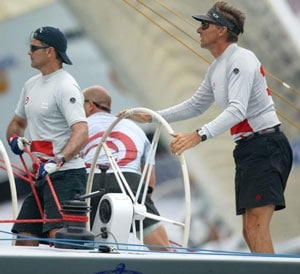
Just in case you’re ever debating why sailing ought to occasionally be a topic in our schools, we have some ammunition in this issue. Likewise, if you’re arguing the benefits of pram sailing for kids. Sure, your standard line of attack might be to enumerate the many recreational, environmental, aesthetic, and commercial values of the natural marine world and sailboats. Not to mention giving children an integrated dose of physics, mechanical engineering, marine biology, psychology, meteorology, etc. But you should also mention that opening up these avenues can also create tomorrow’s champions. When I interviewed the newest members of our Sailing World Hall of Fame, prams and school experiences often came up. Randy Smyth, John Bertrand, and Jochen Schuemann each got their feet wet in a plywood pram dinghy. Smyth and Bertrand started in Sabots, with family encouragement. Schuemann had no sailors in his family, but he loved crafts, and when he heard as an 11-year-old that he could take a course in building a boat, he signed up, built an Optimist dinghy, and then learned to sail it.Bertrand’s most competitive exercise at age 8 was trying to out-capsize his brother. He says, “I just enjoyed mucking around in boats.” Smyth, who soon moved on to a 12-foot Aqua Cat, says, “Races weren’t the driving force. The cat was great because it was faster and I could take more friends.”A door opened for Smyth in high school, at age 16. He says, “There was an announcement in my home room on the P.A. system about jobs as hamburger flippers and so on. Then all of a sudden they said, ‘Sailmaker.’ I said, ‘Sailmaker? That’s me.’ A part-time job soon led him to the Tornado Worlds and a lifetime of successful racing and sailmaking.I asked each Hall of Famer how they had dealt with failure and heard consistent answers. Schuemann had a rare meltdown in the ’92 Olympic Soling medal round and finished fourth. Germany’s reunification had meant Schuemann and crew had to find new jobs and campaign funding, plus qualify for the unified German team. He says, “It was an unusual situation. There was a lot of pressure.” But he refuses to blame his result on external factors, saying, “I didn’t do well enough at the moment where it counts.”Few people would consider fourth a failure, yet Bertrand also had the experience of earning what he calls “the leather medal, the one worse than last.” His turn came right after he’d nearly won the ’72 Finn Gold Cup that year. With only two years in the class, success had come relatively easily to him, as it does to many young sailors. The mark of champions is how they absorb their disappointments and redouble their efforts to succeed, finding the will to improve after each lesson. Bertrand lost badly three times running in the America’s Cup, but he won an Olympic bronze in ’76 and, after falling behind Dennis Conner 3-1, came back to win the Cup in ’83. Pram sailing doesn’t automatically teach us that ability or we might all be Hall of Famers. But if we keep encouraging kids to go have fun in small boats–giving them the freedom to make choices and learn on their own–we’ll produce plenty more champions.If you’d like to learn more about what makes these champions tick, we’ve posted their interviews at sailingworld.com.









